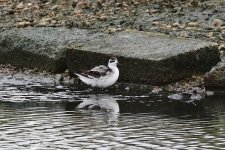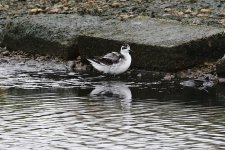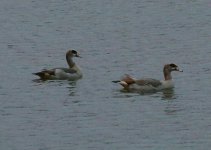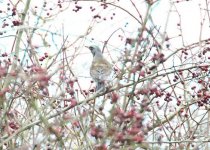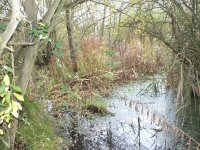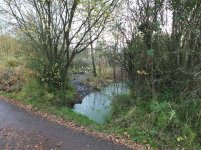-
Welcome to BirdForum, the internet's largest birding community with thousands of members from all over the world. The forums are dedicated to wild birds, birding, binoculars and equipment and all that goes with it.
Please register for an account to take part in the discussions in the forum, post your pictures in the gallery and more.
You are using an out of date browser. It may not display this or other websites correctly.
You should upgrade or use an alternative browser.
You should upgrade or use an alternative browser.
Upton Warren (26 Viewers)
- Thread starter andythomas
- Start date
More options
Who Replied?upstarts1979
Well-known member
A couple of heavily cropped shots also.
crackers Kim:t: john they'll be on my twitter ASAP B
upstarts1979
Well-known member
Red Necked Phalarope
Returned at 4.25pm to the Flashes and was still present at dusk.:t: per SMW
If anyone sees the bird early tomorrow could you please phone/text me or post on here or my twitter account. ASAPB
I can then contact the Trust and cancel the planned work party there...good luck a cracking bird:t:
Returned at 4.25pm to the Flashes and was still present at dusk.:t: per SMW
If anyone sees the bird early tomorrow could you please phone/text me or post on here or my twitter account. ASAPB
I can then contact the Trust and cancel the planned work party there...good luck a cracking bird:t:
Peregrine Trousers
Returning birder after 30 years of hard graft
Spent several hours at the moors from 7am-10:30am
Coot (190), Teal (30), Shoveler (25), Grey Lag (16), Canada (14), Egyptian (2), Pochard (2m+2f), Cetti (2), Gadwall (3m+2f), Cormorant (16), Curlew (13), Kestrel (1m + 1f), Sparrowhawk (1), Wigeon (1m), Long-tailed Tit (30+), Fieldfare (3), Redwing (40)
Egyptian Geese flew off at 7:15am towards flashes.
Afterwards went to flashes to discover that Red-Necked Phalarope was present and showing well
Coot (190), Teal (30), Shoveler (25), Grey Lag (16), Canada (14), Egyptian (2), Pochard (2m+2f), Cetti (2), Gadwall (3m+2f), Cormorant (16), Curlew (13), Kestrel (1m + 1f), Sparrowhawk (1), Wigeon (1m), Long-tailed Tit (30+), Fieldfare (3), Redwing (40)
Egyptian Geese flew off at 7:15am towards flashes.
Afterwards went to flashes to discover that Red-Necked Phalarope was present and showing well
Attachments
Phil Andrews
It's only Rock and Roller but I like it

Today's Red-necked Phalarope is the:
- Tenth record for the reserve
- First autumn record for the reserve
- Latest ever in the WMBC region (beating one at Belvide on 1st November 1952
I believe that Upton is now the second most visited site in the WMBC region, only surpassed by Belvide (are you able to confirm Steve?)
Interestingly the most recent record in Britain was on the 22nd September when a juvenile concluded it's stay at Stretton Sugwas, Herefordshire - could it be the same bird that's been lingering in the region all this time??
- Tenth record for the reserve
- First autumn record for the reserve
- Latest ever in the WMBC region (beating one at Belvide on 1st November 1952
I believe that Upton is now the second most visited site in the WMBC region, only surpassed by Belvide (are you able to confirm Steve?)
Interestingly the most recent record in Britain was on the 22nd September when a juvenile concluded it's stay at Stretton Sugwas, Herefordshire - could it be the same bird that's been lingering in the region all this time??
Last edited:
philip parsons
Active member
Today's Red-necked Phalarope is the:
- Tenth record for the reserve
- First autumn record for the reserve
- Latest ever in the WMBC region (beating one at Belvide on 1st November 1952
I believe that Upton is now the second most visited site in the WMBC region, only surpassed by Belvide (are you able to confirm Steve?)
Interestingly the most recent record in Britain was on the 22nd September when a juvenile concluded it's stay at Stretton Sugwas, Herefordshire - could it be the same bird that's been lingering in the region all this time??
Link to video of the Red-necked Phalarope filmed this afternoon.
Regards to all Upton Warren birders
https://youtu.be/IRue1uZ8Gj0
the wicker man
Well-known member
Returned at 4.25pm to the Flashes and was still present at dusk.:t: per SMW
If anyone sees the bird early tomorrow could you please phone/text me or post on here or my twitter account. ASAPB
I can then contact the Trust and cancel the planned work party there...good luck a cracking bird:t:
Thanks to Steve for calling me back just as I was leaving around 4:25 as the bird flew back in, a few more seconds and I have been gone home!
Phil Andrews
It's only Rock and Roller but I like it

Phalarope still present at the Flashes this morning as per Gert
Last edited:
Gert Corfield
Well-known member

Brief footage of RNP this morning here;
https://flic.kr/p/AUTYfe
https://flic.kr/p/AUTYfe
upstarts1979
Well-known member
please park in overflow car park. Permits for non members will be available in the hide..I will be on site all day so if anyone needs to find out about the bird ..text me john
upstarts1979
Well-known member
phalarope still showing please park in car park .at 10.43:t:
upstarts1979
Well-known member
Would like to thank you for yesterday John. You were an absolute legend. Going to great lengths to make sure everybody got to see the bird.
Thank you very much it means a lot and thanks.
thanks for saying that Andy 😊👍
upstarts1979
Well-known member
for those coming after work o will be on site till dark and will lock car park . so park inside.
ps
bird still here 12.02
ps
bird still here 12.02
upstarts1979
Well-known member
Chris T said phal flew out at 12.20
upstarts1979
Well-known member
still no sign now nearly 2 hours since last seen...I fear the worse. But will be at flashes till dark:t: john
Steve Nuttall
Well-known member
Today's Red-necked Phalarope is the:
- Tenth record for the reserve
- First autumn record for the reserve
- Latest ever in the WMBC region (beating one at Belvide on 1st November 1952
I believe that Upton is now the second most visited site in the WMBC region, only surpassed by Belvide (are you able to confirm Steve?)
Interestingly the most recent record in Britain was on the 22nd September when a juvenile concluded it's stay at Stretton Sugwas, Herefordshire - could it be the same bird that's been lingering in the region all this time??
Hi Phil,
I make it 10 records for Belvide too. Glad to hear you finally connected with the Crag Martin today.:t:
Cheers Steve
upstarts1979
Well-known member
work party at Moors Today
Today 12 of the Lads carried out a couple of tasks.
Bob O, Bob P, Bob R, Dave H, Jim B, John C, Paul M, Peter E, Ray C, Roger, Terry W and Tony B. :t:
I had a day on car park and hide duty welcoming visitors coming for the phalarope.
1st was to repair the stock fence in the SW marsh. A large willow had fallen on it and this allowed the cattle to get into the stream. The fence was repaired and the tree pollarded.
2nd work started on the swampy bottom and secret garden areas. The willows have grown tall and enclosed the area along the inlet channel on the causeway.
The large fallen willows were coppiced and the brash piled up a a dead hedge along the causeway.
pic 1 before work in swampy bottom pic 2 after the work.
We will continue in this area next week as well as reed bed cutting in the car parkB
Today 12 of the Lads carried out a couple of tasks.
Bob O, Bob P, Bob R, Dave H, Jim B, John C, Paul M, Peter E, Ray C, Roger, Terry W and Tony B. :t:
I had a day on car park and hide duty welcoming visitors coming for the phalarope.
1st was to repair the stock fence in the SW marsh. A large willow had fallen on it and this allowed the cattle to get into the stream. The fence was repaired and the tree pollarded.
2nd work started on the swampy bottom and secret garden areas. The willows have grown tall and enclosed the area along the inlet channel on the causeway.
The large fallen willows were coppiced and the brash piled up a a dead hedge along the causeway.
pic 1 before work in swampy bottom pic 2 after the work.
We will continue in this area next week as well as reed bed cutting in the car parkB
Attachments
Last edited:
upstarts1979
Well-known member
Birding at the Moors today,
After the Phalarope had departed, I went to the Moors.
The Lads had finished the work and were gathered in the East hide. No cake so I had to bird8-P
The water had dropped 5 to 6 cm's since last Tuesday and we plan to take a bit more off so we can work on the reed beds.
Snipe Island was exposed a bit more but still no snipe on it, although there were a few on the promontory.
No great happenings today and with a temperature of 16 degrees not expecting too much.
Species count:
Little grebe 5, shoveler 35, teal 12, gadwall pr, pochard 4 (2 prs), tufted c17, coot 220, water rail 3 along east side. Egyptian geese 2, greylag 23, snipe 7, curlew 9, lapwing 2, kestrel, cettis w 3, siskin 2,
After the Phalarope had departed, I went to the Moors.
The Lads had finished the work and were gathered in the East hide. No cake so I had to bird8-P
The water had dropped 5 to 6 cm's since last Tuesday and we plan to take a bit more off so we can work on the reed beds.
Snipe Island was exposed a bit more but still no snipe on it, although there were a few on the promontory.
No great happenings today and with a temperature of 16 degrees not expecting too much.
Species count:
Little grebe 5, shoveler 35, teal 12, gadwall pr, pochard 4 (2 prs), tufted c17, coot 220, water rail 3 along east side. Egyptian geese 2, greylag 23, snipe 7, curlew 9, lapwing 2, kestrel, cettis w 3, siskin 2,
Similar threads
- Replies
- 1
- Views
- 1K
Users who are viewing this thread
Total: 27 (members: 1, guests: 26)




